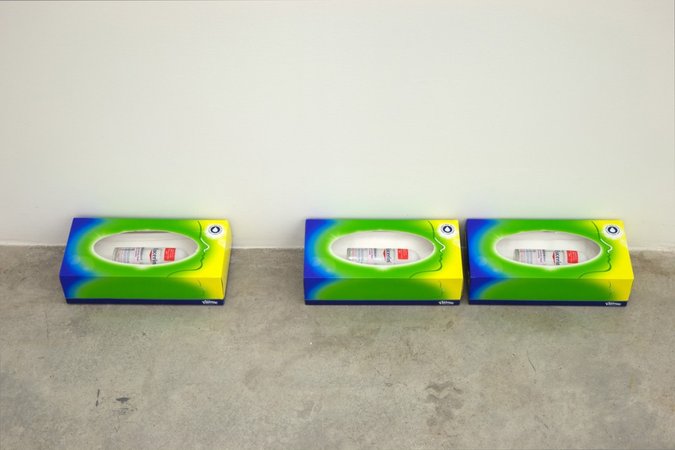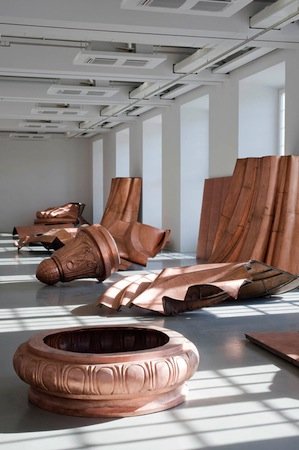2017 will mark the 100th anniversary of the day Marcel Duchamp walked into the Society of Independent Artists lugging a porcelain urinal he had purchased at 5th Avenue's J. L. Mott Iron Works and submitted it as a "readymade" sculpture. Duchamp's radical and audacious gesture was met, at the time, with shock and indignation—it was literally hidden away behind a screen during the Society's 1917 exhibition—but remains the primary touchstone for much contemporary sculpture. Contrary to the negative reaction that Duchamp received, we’ve now come to not only accept, but to expect sculptural artwork that appropriate commercial items and focusses on setting unexpected elements in juxtaposition with one another.
Such work might, at first glance, seem like rehashed Dada or (as the art critic Michael Sanchez has suggested) a revisiting of the Surrealist use of objects—and, in many ways, the driving impulse behind this kind of art is the same as it was a century ago. Dada and its successor-movement Surrealism emerged in European circles out of an ironic desire to engage irrationality and the subconscious mind as reactions against the atrocities wrought by highly rationalized and technologized warfare in World War I. (Think of Dalí ’s Lobster Telephone , which emerged as the emblematic example of Surrealist sculpture by placing found materials in simple but stark juxtapositions to evoke subconscious desires.) Today, in the current age of rapid technological advancement, artists are once again interested in the evocative powers of everyday material objects—though filtered through the additional insights granted by the past half-century of artistic development.
With MoMA PS1 opening an exhibition dealing with exactly these themes later this month—"Taster's Choice," a group show curated by Christopher Lew —it's a good time to take a look at the ways artists are tackling the subject. The real surprise here might be the idea that anything novel can be done with objects at all. So, how is it that recent sculpture "works"? What does it say about the materials it's made from? Here's a brief primer.
THE RETURN OF THE SURREALIST OBJECT
 Jason Dodge's
What we keep doing to ourselves
(2014)
Jason Dodge's
What we keep doing to ourselves
(2014)
In many ways, Jason Dodge 's recent show at Casey Kaplan Gallery represents what we expect contemporary sculpture to be: neatly assembled, laconic, and elegant, but also complex, somewhat humorous, and presenting a narrative that needs to be teased out. In Dodge's exhibition, found objects were arranged throughout the space in spare combinations, leaving much of the gallery empty. Paper shopping bags full of groceries sat in the doorways of the first and last galleries; a large wicker basket held an illuminated light bulb aloft, so that it nearly touched a second bulb attached to a nearby wall; a canary-yellow pillow lay on the floor next to a metal chimney turned on its side and mounted on slight plinths to transform it into a piece of minimalist sculpture; tubular piping and a long power cord cut abruptly through the gallery's walls.
What was not apparent from either walking through the galleries or referring to the exhibition's equally gnomic press release was the story behind these objects. The basket was made by a blind German weaver, who was asked by Dodge to make the largest basket he could picture "in his mind's eye"; the pillow had purportedly only ever been slept on by the Mayor of Nuremberg; the chimney pointed due north, serving as an axis for the rest of the exhibition; the piping contained hidden poison hemlock seeds; the power cord ended, in the final gallery, with its sprocket sunk into a tank of water, displaying its own uselessness. Clearly, none of this could be discerned from looking at the works themselves—the content, and therefore the artistic value, was only available to those who were willing and able to extract it. Such is one form of conceptual sculpture in the new information economy.
COMMODITY MINIMALISM
 An installation view of Darren Bader's 2012 show at MoMA PS1
An installation view of Darren Bader's 2012 show at MoMA PS1
Beside its Surrealist origins, recent sculpture finds just as much of its heritage in the Minimalism of the 1960s and '70s, when artists embraced the use of stark industrial materials in large-scale, austere forms that emphasized the art object's physical presence and stripped away any illusionistic figuration. As cutting-edge industrial materials like sheet steel and cast iron and technologies like plastic vacuum-forming and fiberglass molding became widespread and inexpensive, artists began to explore ways of working with them that were radically different than what Duchamp had done, creating sprawling and often site-specific geometric works that were nothing more than the complete expression of their sculptural idea. (As Frank Stella said of his minimalist paintings from the period, "What you see is what you see.")
Now, post-conceptual artists are again picking up this Minimalist approach to claim commercial, utilitarian materials as the stuff of their sculptures. Thanks to the ubiquity of cheaply produced, cheaply bought consumer products that have proliferated since the 1970s, artists' use of readymade manufactured objects has been extended from industrial materials to consumer goods, employing entire items that were designed to be used and discarded. In recent sculpture, artists like Dodge, Tony Feher , and Klara Lidén have used, respectively, plastic deodorant sticks, shopping bags, and garbage cans in the same way Minimalist artists used sheet steel, cast iron, and lacquered wood—simultaneously referring back to Duchamp's original readymades of a urinal, a snow shovel, and a bottle rack.
In a recent exhibition at MoMA PS1, Darren Bader went so far as to place burritos on a windowsill, fresh vegetables on pedestals (they were regularly made into a salad by a performer), and three cats up for adoption on display and claimed them as sculptures. Rather than sticking to stark industrial materials, the artists working in this post-conceptual mode free themselves up to use the ephemera of everyday life. Today, pretty much any commodity—even food items, clothing, domesticated animals, and so on—can be taken up as sculptural material.
SOCIAL ARCHEOLOGY
 Danh Vo's
We the People
(2010-ongoing)
Danh Vo's
We the People
(2010-ongoing)
In addition to using commercial brands, artists have recently started to work with objects that are associated with elaborate social and political histories to make a kind of sculpture that, at first, can seem more akin to anthropology than fine art. Danh Vo is probably the best-known figure working in this manner of post-conceptual sculpture today; one of Vo's 2011 sculptures consists of a disassembled chandelier that once hung in the ballroom of Paris's Hotel Majestic, where the Paris Peace Accords were signed in 1973, laid out on the floor as if on display in an archeological museum. For Vo, the objects he finds are tied to his own personal history as a Dutch-born Vietnamese artist, who as a child fled that country with his parents in a homemade boat; many of the objects he uses are linked to Vietnam's colonial history. Vo's latest large-scale work, true-to-scale bronze casts of pieces of the Statue of Liberty, will be going on display in both Downtown Manhattan's City Hall Park and Brooklyn Bridge Park in mid-May this year.
OBJECTS AS IMAGES AS MEMES
 Timur Si-Qin
Axe Effect
(2011-2013)
Timur Si-Qin
Axe Effect
(2011-2013)
As one can probably tell from recent shows, artists are also using found commercial objects in their work to comment on the way images on the Internet are endlessly reused, recycled, and remixed. Richard Dawkins 's 1976 book The Selfish Gene famously coined the now ubiquitous term 'meme' to draw a comparison between genetic evolutionary models and the way information is transferred, with a meme being a unit of culture the same way a gene is a unit of biology. The current state of sculpture dovetails perfectly with meme culture: the unique setting of the art gallery allows real objects to be treated as cultural signifiers—of an idea, a fad, or a subculture, for instance—by positioning real, physical, consumer items within the gallery. Timur Si-Qin ’s humorous readymade sculptures use products from popular culture in order to highlight this shift in the way we see brands. The artist's commodity items, stopped in their commercial trajectories and frozen in the art gallery, represent not only the art-historical strategies that allowed them to be placed them there—they also represent the radical transformation, in real time, of the way we see and experience the world at large.
























